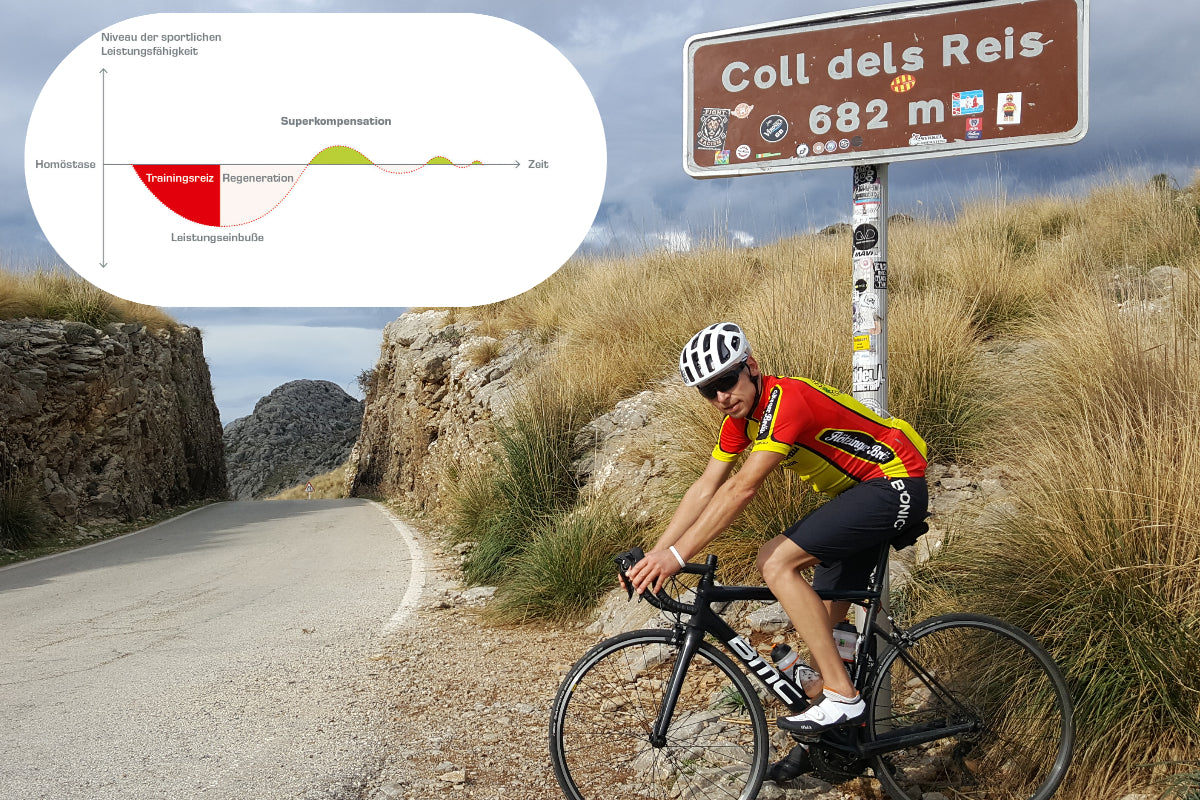Die Superkompensation ist ein Erklärungsmodell für körperliche Anpassungsprozesse in Folge von Trainingsbelastungen. Während der Regeneration erholt sich der Körper über das Ausgangsniveau hinaus und gelangt dadurch in eine Phase erhöhter Leistungsfähigkeit. Wie sie genau funktioniert und welchen Einfluss sie auf euer Training und Erholung hat, erfahrt ihr in folgendem Beitrag.
Definition
“Super” kommt aus dem lateinischen und bedeutet unter anderem “über etwas hinaus”. Der zweite Teil, “Kompensation” steht für Ausgleich. Zusammen ergibt das also etwas wie “Überausgleich”, was das Prinzip bereits ganz gut beschreibt.
Die Superkompensation ist also die Anpassungsreaktion des Körpers über das ursprüngliche Niveau hinaus als Folge einer Trainingsbelastung.
So funktioniert die Superkompensation
Abbildung: Modell der Superkompensation
Im Normalzustand befindet sich der Körper in einem Gleichgewicht (Homöostase). Um eine Superkompensation herbeizuführen, muss der Körper aus diesem Gleichgewicht gebracht werden, d.h. raus aus der Komfortzone. Dies erfolgt im Sport durch den sogenannten trainingswirksamen Belastungsreiz, also einer Trainingseinheit. Während der Belastung sinkt die Leistungsfähigkeit in Folge zunehmender Ermüdung. Nach dem Training beginnen nun die regenerativen Prozesse, die zur Superkompensation führen. Diese finden auf vielen unterschiedlichen Ebenen im Körper statt und wirken sich dabei so stark aus, dass sich die Systeme über das Ausgangsniveau hinaus anpassen, also leistungsfähiger sind. Das betrifft sowohl strukturelle (Knochen, Muskeln, Sehnen und Bänder) als auch physiologische Funktionen (Herz-Kreislauf-System, Energiestoffwechsel, Abläufe in den Muskelzellen). Insgesamt handelt es sich dabei eigentlich um eine Schutzreaktion des Körpers, um auf eine Folgebelastung besser vorbereitet zu sein. Die Grafik macht jedoch auch deutlich, dass sich die Anpassungsprozesse wieder zurückbilden, falls keine weitere Belastung stattfindet.
Langfristiger Leistungszuwachs
Abbildung: Verbesserung der sportlichen Leistungsfähikeit durch optimal gesetzte Trainingsreize
Um den Effekt der Superkompensation für einen konstanten Formaufbau zu nutzen, müssen also kontinuierliche Belastungsreize immer wieder neu gesetzt werden, um den Körper zu dieser Anpassung zu "zwingen". Wichtig dabei: die Folgebelastung sollte in der Phase der Superkompensation (also auf dem erhöhten Leistungsniveau) stattfinden, um überhaupt davon profitieren zu können.
Falls die folgenden Trainingsbelastungen zu früh gesetzt werden, kann es zu einer gegenläufigen Leistungsentwicklung kommen.
Abbildung: Abnahme der sportlichen Leistungsfähikeit durch zu schnell aufeinander folgende Trainingsreize
Woher weiß ich, wann ich die Phase der Superkompensation erreicht habe?
Nach einer "durchschnittlichen" Trainingseinheit ist der Höhepunkt der Superkompensation nach ca. 1-2 Tagen der Erholung erreicht und daraufhin für ca. 2-3 Tage aktiv ist, bevor es zur Rückkehr auf das Anfangsniveau kommt. Das lässt sich allerdings nicht so pauschal festlegen, da diese Werte stark abhängig sind von:
- aktuellem Leistungsniveau (Profi-Athleten haben eine kürzere Regenerationszeit als Hobbysportler)
- Art & Intensität des Reizes
- Möglichkeit der Regeneration
- Alter
- Ernährung
Wichtig ist: je intensiver die Trainingsbelastung war, je stärker man sich also "in den Keller" gefahren habt, umso länger dauern die Regenerationsprozesse. Diese finden je nach Anpassungsebene unterschiedlich schnell statt und können von Stunden bis hin zu Wochen dauern, z.B. ist die Auffüllung der Energiespeicher nach einem langen Lauf bereits nach kurzer Zeit abgeschlossen, wohingegen die muskulären Strukturen jedoch deutlich länger brauchen, um eine große Belastung zu kompensieren (z.B. Marathon).
Auf den Körper hören
Das Konzept der Superkompensation beruht größtenteils auf Forschungen aus den 70er Jahren, die sich nur mit der Wiederauffüllung von Substratspeichern (Glykogen) beschäftigt haben. Viele andere Anpassungsprozesse wurden hierbei nicht berücksichtigt. Es kann also beispielsweise dazu kommen, dass die Substratspeicher zwar voll sind, die Muskeln aber aufgrund einer zu starken Reizintensität noch “beschädigt” sind. Das wäre spürbar durch starken Muskelkater und das Training sollte bis zur vollständigen Erholung ausgesetzt werden, auch wenn man dadurch eventuell die Superkompensationsphase verpasst.
Insgesamt ist das hier vorgestellte Konzept durchaus hilfreich um einen nachhaltigen Anstieg des Leistungsniveau zu bewerkstelligen. Aber man sollte trotzdem immer auf seinen Körper hören, da Training ohne ausreichende Erholungsperioden keine positiven Effekte bringt.
Der trainingswirksame Belastungsreiz
Damit eine Belastung auch wirklich trainingswirksam ist und die gewünschten Anpassungen hervorruft, muss diese eine bestimmte Schwelle überschreiten, um den Körper überhaupt erst aus dem Gleichgewicht zu bringen. Das lässt sich am besten an einem Beispiel erläutern:
Absolviert ein Lauf-Anfänger einen 5 oder 10 Kilometer Lauf in einem 5-er Schnitt (5 min/km), ist er damit wahrscheinlich an seiner Belastungsgrenze und am Ende energetisch und muskulär komplett erschöpft. Läuft Jan Frodeno diese Distanz im gleichen Tempo, wäre das wohl höchstens eine Einheit aktiver Regeneration, nicht aber für den Leistungsaufbau.
Mit dem Anstieg der Leistungsfähigkeit muss sich also auch der leistungswirksame Reiz verändern - in Umfang und Intensität. Im Rahmen der progressiven Belastungssteigerung werden dann auch zunehmend mehrere Trainingseinheiten zu einem zusammenhängenden Trainingsreiz zusammengefasst (z.B. Trainingslager).
In jeder Trainingseinheit entscheidet grundsätzlich die Art der Belastung darüber, welche Systeme mit dem Training in erster Linie angesprochen werden und sich dann weiterentwickeln. Die Verbesserung der maximalen Sauerstoffaufnahmefähigkeit (VO2max) ist beispielsweise mit ganz anderen funktionellen Prozessen verknüpft als die Verbesserung und Ökonomisierung des Fettstoffwechsels. Also setzen beide Zielstellungen auch ganz unterschiedlich ausgestaltete Trainingsreize voraus (Methode, Umfang, Intensität). Für die optimale Gestaltung der Trainingseinheiten ergeben also folgende Forderungen:
- Kenne Deine individuellen Trainingsbereiche als Steuergröße Deiner Trainingsbelastungen
- setze unterschiedliche Trainingsreize, die zu unterschiedlichen Anpassungen führen
- kombiniere Trainingseinheiten im wöchentlichen Trainingsplan sinnvoll miteinander
- achte auf Regeneration - erst durch Erholung wirst Du besser!
Mehr Beiträge zum Thema




















